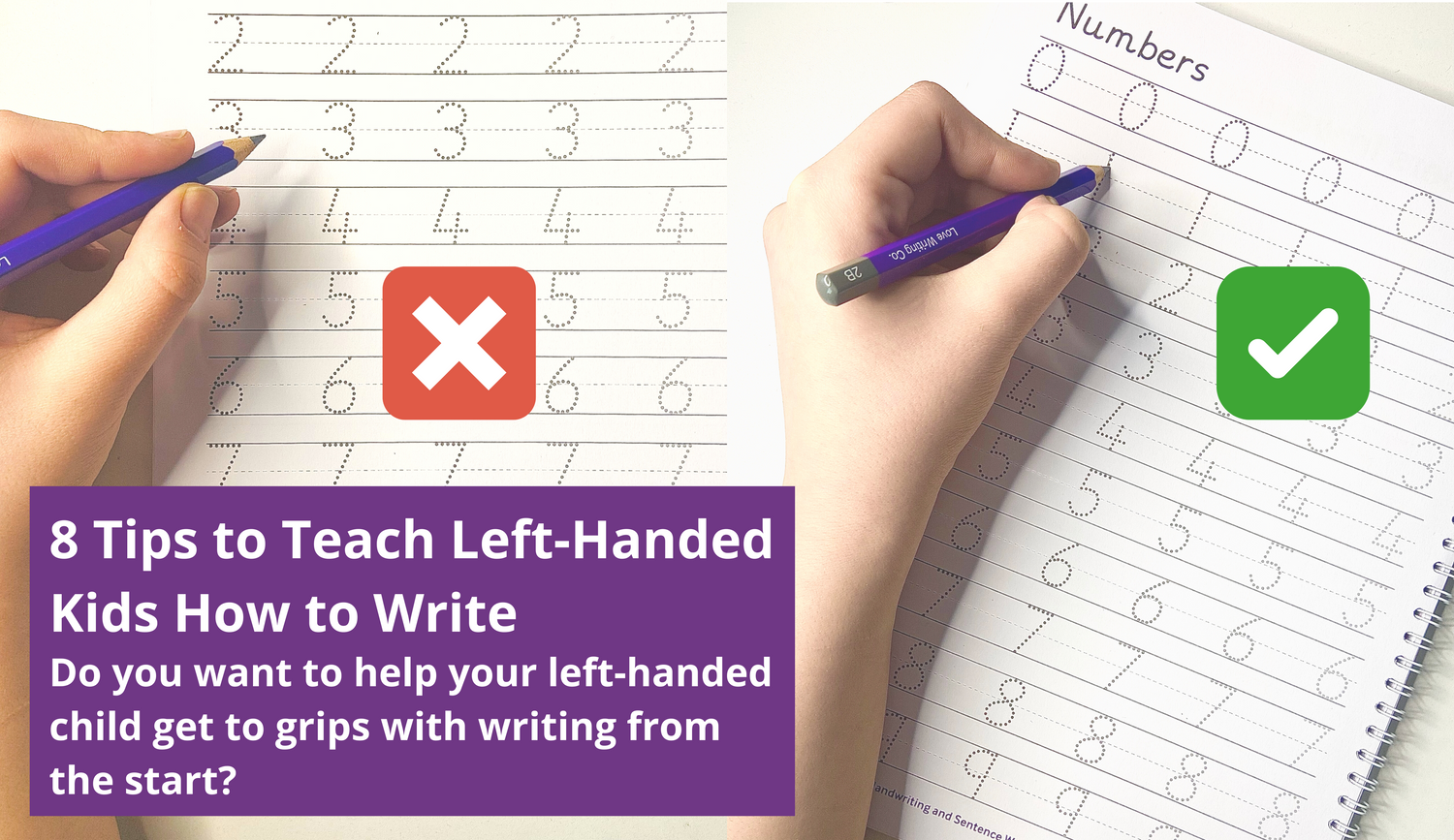Did you know that 10% of the world's population writes with their left hand? Learning how to write can be a difficult process and often even more so when left-handed. Here at Love Writing Co. we have expertly designed all of our handwriting practice resources to be suitable for right and left-handers.
There are several techniques, hints and tips that you can incorporate in everyday writing life to help teach left-handed children to write.
For example, a tip many may not realised as that it is great to encourage left-handed children to move their pencil in a certain manner on paper - the movement for left-handers is to push instead of pulling on the page, as right handers do.
We know how important it is to start off on the "right foot" from the beginning of every child's handwriting journey as not doing so may leave to difficulties such as poor pencil control, muscle fatigue and excessive smudging in the future that lead to reluctant writing.
We've put together our Top 8 Useful Tips to help your left-handed child get to grips with writing from the start.
You will also find links to writing resources developed to make learning to write quicker, easier and fun! Ages 3-5: Complete Learning To Write Pack and Ages 6-9: Better Writing Pack are chosen by 100's of parents every single day for their for left and right-handed children.
In this blog, you will find:
1. Position the paper correctly.
2. Use the right hand for stability.
3. Keep the wrist below the line to avoid the ‘hook’ hand.
4. Hold the pencil in the right place.
5. Practice the tripod grip.
6. Sit lefties on the left.
7. Use the correct tools.
8. Use writing practice sheets.
Do you need more tips? Subscribe to our newsletter here to access all of your learning hints, tips & free handwriting sheets. Exclusive offers await you!
1. Position the paper correctly (so important!).
When your child sits to practice handwriting, sit their paper slightly to the left of centre, and rotate it roughly 45 degrees clockwise (moving the top right corner down slightly). This makes it easier for your child to see the nib of the pencil as they're writing.
Take a look at these examples below to help.
2. Use the right hand for stability.
Help your child place their right hand flat on the right-hand side of the paper to prevent the page from shifting as they write.
Stability when writing is a big factor in writing comfortability. That's way our handwriting pencils are uniquely designed with a Tripod Grip, softer core and hexagonal shape with correct diameter and length to fit children's hands. This means when used, our pencil reduce hand and wrist fatigue, encourage correct tripod grip and allow children to write for longer with ease.
Try out out packs of handwriting pencils here: available in ages 3-5 and 6-9 years.
3. Keep the wrist below the line to avoid the ‘hook’ hand.
Without guidance, left-handed writers often develop an uncomfortable ‘hooked’ wrist position, where the wrist curls in order to see what they’re writing and not smudge their work.
It is important to encourage your child to keep the pencil on the line, with the wrist below the line to improve their vision, reduce arm strain and prevent smudging.
Correct paper positioning and pencil grip will also help maintain this correct hand position. Our handwriting and A-Z activity workbooks are all ring-binded in order to allow left-handers to comfortably lay each page flat to complete. Available on offer shop here.
See images below as guidance.
4. Hold the pencil in the right place.
Ideally left-handers should hold the pen or pencil roughly 2-3 cm from the point to enable them to see their writing and avoid ‘hooking’ with the writing hand or adopting awkward neck posture when writing.
Indicate where they should hold the pencil with a line of nail varnish or a small elastic band wrapped around the desired area, which can be removed once the child is familiar with the position.
5. Practice the tripod grip.
Show your child how to hold the pen/pencil with the correct tripod grip between the thumb, index and middle fingers. This grip, taught during the early stages along with sitting and paper position, should eliminate the ‘hooked’ hand problem.
See image below as an example.
Discover more about our Tripod Grip pencils here.
6. Sit lefties on the left.
If you’re helping more than one child with their handwriting practice or homework, be sure the left-handed child is sitting on the left to avoid their elbows clashing as they write.
It is important for left-handers to feel they have enough space too without interruption.
7. Use the correct tools.
When children start writing, it is far easier to use soft leaded pencils rather than pens to reduce writing pressure and avoid smudging. Pencils with broader and softer leads - 2B rather than HB - help reduce writing pressure. Whilst pencils with a wider diameter are well-suited to left-handers as they encourage the critical tripod grip.
Love Writing Co. Pencils are specially designed for little hands as they have a wider diameter so they are easier to hold, a softer core so the pencil moves smoothly across the page, and a hexagonal shape to encourage the correct tripod grip. The pencils are also the correct length for a child's hand, making them easy to balance and control - perfect for left-handers.
Click here to shop left-handed writing packs
8. Use writing practice sheets.
By using fun-filled writing sheets with fun characters and rewards throughout the pages can work as a great to way encourage your child. Children often will feel greater encouragement and consider practising their writing as something enjoyable rather than a dull task.
Love Writing Co. have a selection of engaging Handwriting Practice Books supporting KS1 learning which support the UK School Curriculum with cursive and pre-cursive handwriting practice. You can buy them in an integrated pack together with others useful writing resources: Ages 3-5: Complete Learning To Write Pack and Ages 6-9: Better Writing Pack or as a single products to test out.
We hope you've found this helpful and if you are looking for more hints, tips and tricks for handwriting for early learners (left and right-handers) then be sure to Subscribe to our newsletter.
Be kept up to date with regular advice and lots of Exclusive free handwriting sheets including 6 free worksheets when you sign up to our newsletter!
Happy Writing! We'd love to hear from you - feel free to contact us anytime at hello@lovewritingco.com.









7 comments
Carla zelaya
very helpful. Thank you!
Carla zelaya
very helpful. thank
Dawne Wallerson
Thanks for such informative content.
Bunkerintegrated
Thank you for sharing these practical tips! Teaching left-handed children to write can be tricky, but your guidance makes it seem much more manageable. Great job!
jeremydavidson@gmail.com
Thanks for the tips
Leave a comment
All comments are moderated before being published.
This site is protected by hCaptcha and the hCaptcha Privacy Policy and Terms of Service apply.